As loving pet parents, we often share everything with our furry companions, including our food. It’s a natural instinct to want to treat our dogs, and sometimes, a little bite from our plate seems harmless. However, the human digestive system and canine metabolism are vastly different, meaning many everyday foods safe for us can be incredibly dangerous, or even fatal, for dogs. Pet poisonings are a significant concern, with hundreds of thousands occurring annually in the United States alone. While not all are food-related, common household foods are a major contributor, making it crucial for every dog owner to understand the risks.
The desire to provide the best care for our beloved dogs extends to their diet. Knowing precisely what our dogs can and cannot eat is not just a recommendation—it’s a critical aspect of responsible pet ownership. This comprehensive guide from Dog Care Story aims to be your essential resource, detailing common foods that are toxic to dogs, explaining why they are harmful, and offering advice on how to prevent accidental ingestion and respond to emergencies. By arming yourself with this knowledge, you can proactively safeguard your dog’s health and ensure their safety from potentially life-threatening food hazards. Understanding these dietary boundaries is fundamental to nurturing a healthy and happy life for your canine companion. For a positive contrast, knowing what foods can my dog eat can also help you choose healthy treats.
Understanding Canine Digestion: Why Some Human Foods Are Toxic
Have you ever wondered why dogs can’t eat the same foods as humans? The answer lies in the fundamental differences between canine and human biology, particularly concerning their digestive systems and metabolic processes. While humans have evolved to process a wide variety of foods, dogs’ bodies handle certain substances very differently, making some common human foods highly toxic to them.
For instance, the compounds theobromine and caffeine, found in chocolate, are metabolized much slower by dogs than by humans. This slower breakdown means these substances can rapidly accumulate to toxic levels in their system, leading to severe health issues and potentially fatal outcomes. Similarly, while you might enjoy a cherry, the pits, stems, and leaves contain cyanide, which can be problematic if ingested in large quantities by a dog. Beyond chemical toxicity, physical hazards like fruit pits can also cause gastrointestinal obstructions or irritation, leading to diarrhea or more severe complications.
The degree of food toxicity can also vary significantly based on individual factors such as the dog’s size, breed, and overall health condition. A small dog consuming a seemingly minor amount of a toxic substance may experience much more severe effects than a large dog. Certain breeds may also have genetic predispositions that make them more sensitive to particular compounds. This variability underscores the importance of consulting with your veterinarian if you ever have questions or concerns about specific foods or if your dog has accidentally ingested something questionable. Their professional guidance is invaluable in ensuring your dog’s safety and well-being.
A Comprehensive List of Foods Dogs Cannot Eat
Many seemingly innocuous household foods pose significant dangers, and often toxicity, to dogs. It’s crucial for every pet owner to be aware of these items to prevent accidental ingestion. While this list is extensive, it serves as a critical overview, not an exhaustive compilation of every single forbidden food. Always err on the side of caution when in doubt.
1. Alcohol
Because dogs and cats are significantly smaller than humans, alcohol can have a far more devastating impact on their systems. Even minute amounts can be harmful, and the risk escalates with a pet’s smaller size. Symptoms of alcohol poisoning in dogs mirror those in humans, including vomiting, profound breathing difficulties, coma, and tragically, even death. It is imperative to keep all alcoholic beverages and products containing alcohol far out of reach.
 Dog sniffing a spilled alcoholic beverage on the floor, highlighting the danger of alcohol for pets.
Dog sniffing a spilled alcoholic beverage on the floor, highlighting the danger of alcohol for pets.
2. Apple, Apricot, Cherry, and Plum Seeds/Pits
While the fleshy part of apples (without seeds) can be a safe treat, the core and especially the seeds are not. Apple seeds contain cyanide. Although small amounts might not be immediately dangerous, it’s safest to avoid the core and seeds entirely. Similarly, apricot, cherry, peach, and plum seeds and pits must be avoided. These fruit pits also contain cyanide, a potent toxin that can disrupt the red blood cells’ ability to carry oxygen. Ingestion can lead to vomiting, irregular and rapid heartbeat, seizures, coma, and potentially death. Furthermore, the hard pits can cause choking or gastrointestinal obstruction.
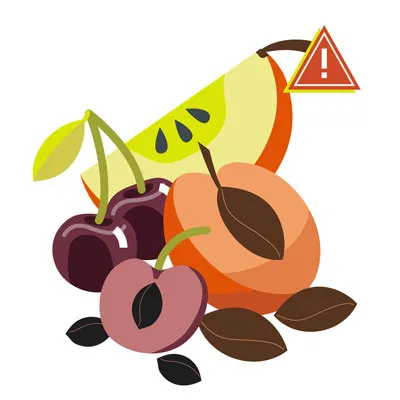 Assortment of fruit seeds and pits from apples, apricots, cherries, and plums, emphasizing their toxic nature for dogs.
Assortment of fruit seeds and pits from apples, apricots, cherries, and plums, emphasizing their toxic nature for dogs.
3. Avocado
Avocados are generally not a recommended food for dogs. They contain persin, a fungicidal toxin, which has been linked to myocardial damage and adverse reactions in various animal species, including dogs, although such severe cases are rare. Beyond the chemical concern, the large, intact avocado pit presents a significant choking hazard and can easily obstruct a dog’s gastrointestinal tract, necessitating emergency veterinary intervention. Therefore, it’s best to keep avocados away from your canine companions.
 Whole avocado with a sliced half showing the large pit, indicating a food to be avoided by dogs.
Whole avocado with a sliced half showing the large pit, indicating a food to be avoided by dogs.
4. Broccoli
Broccoli contains isothiocyanates, compounds that can be harmful to pets if consumed in very large quantities. While a small, occasional amount might not cause immediate harm, given the availability of many healthier and safer vegetable options, it’s generally best to avoid feeding broccoli to your dog. Additionally, the fibrous stalks of broccoli can pose a choking risk, or if swallowed, can cause gastrointestinal upset or even obstruction in some dogs.
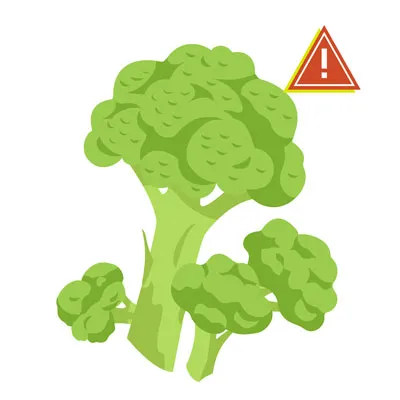 Head of fresh green broccoli florets, a vegetable that should be given to dogs with caution or avoided.
Head of fresh green broccoli florets, a vegetable that should be given to dogs with caution or avoided.
5. Caffeine and Coffee Grounds
Caffeine, found in coffee, tea, energy drinks, and some medications, contains methylxanthines. These stimulants can be extremely dangerous, causing a range of potentially fatal symptoms in dogs, including diarrhea, vomiting, seizures, hyperactivity, and an irregular heartbeat. Ingesting coffee grounds or highly caffeinated beverages can cause a dog’s heart rate to accelerate dangerously, leading to tremors, arrhythmia, difficulty breathing, and other severe neurological and cardiovascular issues. All forms of caffeine, even small amounts, are a serious threat.
 Bowl of coffee beans and coffee grounds, highlighting the danger of caffeine for dogs.
Bowl of coffee beans and coffee grounds, highlighting the danger of caffeine for dogs.
6. Chicken and Turkey Skin, Ham, and Other Fatty Cuts of Meat
Fatty meats, including the skin from chicken or turkey, ham, bacon, and other high-fat trimmings, should be strictly avoided. These are detrimental to dogs due to their extremely high fat content, which can trigger acute pancreatitis. Pancreatitis is a life-threatening inflammatory condition of the pancreas that causes severe abdominal pain, vomiting, diarrhea, and can lead to serious complications. Furthermore, while the meat itself might be safe, turkey and chicken bones (especially cooked ones) are brittle and can splinter. These splinters can cause internal injuries, obstruct the bowels, or perforate the stomach or intestines, potentially leading to fatal abdominal infections.
 Various fatty cuts of meat including chicken skin and ham slices, illustrating foods dangerous for canine health.
Various fatty cuts of meat including chicken skin and ham slices, illustrating foods dangerous for canine health.
7. Chocolate
Chocolate toxicity is one of the most frequently reported causes of pet poisoning, particularly during holidays when it’s abundant. No dog should ever consume any chocolate product. Chocolate contains a compound called theobromine, which dogs cannot metabolize efficiently. The darker the chocolate, the higher its theobromine content and thus, the greater the danger. Chocolate also contains caffeine, and some sugar-free variations may even contain xylitol, an additional potent toxin for dogs.
Dogs and cats are simply unable to process chocolate as effectively as humans. Baker’s chocolate and dark chocolate are the most dangerous, but any type of chocolate, even milk chocolate or white chocolate, can cause problems. Symptoms of chocolate ingestion can include hyperactivity, vomiting, diarrhea, pancreatitis, abnormal heart rhythms, and seizures. If your dog ingests any amount of chocolate, even a tiny piece, contact your veterinarian immediately; prompt action is crucial.
 Assortment of chocolate bars, chips, and cocoa powder, representing a highly toxic food for dogs.
Assortment of chocolate bars, chips, and cocoa powder, representing a highly toxic food for dogs.
8. Grapes and Raisins
Grapes and raisins are exceptionally dangerous for dogs and can cause severe health issues, including acute kidney failure. The toxic component, tartaric acid, is highly damaging to canine kidneys. Even a small number of grapes or raisins can be enough to cause serious problems in susceptible dogs. Symptoms of raisin or grape poisoning often include initial vomiting and diarrhea, followed by lethargy, loss of appetite, abdominal pain, and significant changes in urine output, potentially leading to an inability to produce urine. This is a medical emergency requiring immediate veterinary attention.
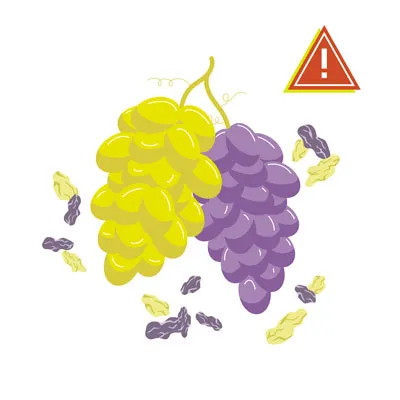 Fresh green and red grapes alongside dried raisins, signifying a toxic fruit combination for dogs.
Fresh green and red grapes alongside dried raisins, signifying a toxic fruit combination for dogs.
9. Macadamia Nuts, Almonds, and Pistachios
Macadamia nuts are particularly toxic to dogs, capable of causing numerous painful symptoms such as weakness, tremors, overheating (hyperthermia), and vomiting. While the exact mechanism of their toxicity remains somewhat unclear, these nuts are definitively considered dangerous. As few as six macadamia nuts can induce severe poisoning in a small dog.
Other nuts, while perhaps not as acutely toxic as macadamia nuts, can also pose problems. Almonds and pistachios, for example, are often choking hazards due to their size and hard texture. Furthermore, many commercially prepared nuts are flavored, salted, or spiced, and these additives can be unhealthy or even toxic themselves. It’s best to keep all nuts out of your dog’s diet.
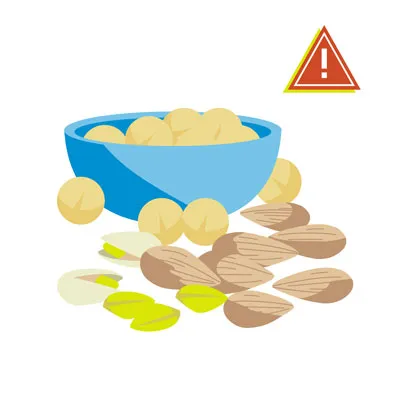 Pile of macadamia nuts, almonds, and pistachios, illustrating various nuts that are problematic or toxic for dogs.
Pile of macadamia nuts, almonds, and pistachios, illustrating various nuts that are problematic or toxic for dogs.
10. Milk and Dairy Products
The suitability of milk and other dairy products for dogs is highly individualized. Some dogs can tolerate them without issue, while others are lactose intolerant or have dairy allergies. For lactose-intolerant dogs, consuming cow’s milk or other dairy can lead to gastrointestinal distress, including diarrhea and excessive gas.
Ice cream, in particular, should be avoided due to its high sugar and fat content, which can cause digestive upset or contribute to pancreatitis. Instead of ice cream, consider offering your pup small, frozen bites of safe fruits for dogs as a healthier, refreshing treat. Small quantities of lower-fat cheese can be acceptable as an occasional treat if your dog tolerates dairy, but high-fat varieties should be limited.
 Glass of milk and a cheese wedge, representing dairy products that some dogs may not tolerate well.
Glass of milk and a cheese wedge, representing dairy products that some dogs may not tolerate well.
11. Mushrooms
It is always safest to err on the side of caution and prevent your dog from eating any mushrooms. Wild mushrooms, in particular, can contain a wide array of toxins that may lead to severe health problems such as kidney and liver failure, vomiting, diarrhea, neurological symptoms like hallucinations, and damage to red blood cells. Even store-bought white button mushrooms, while generally considered non-toxic after being washed, are best avoided given the potential for misidentification or other contaminants. Choosing a different, known-safe treat is always the wiser option to protect your dog.
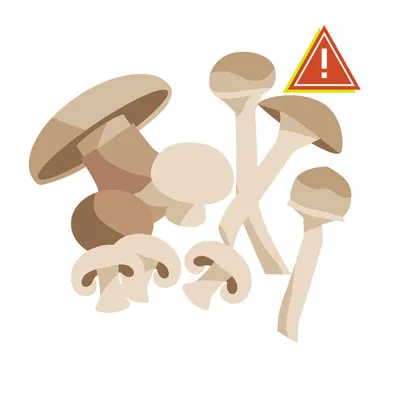 Assortment of wild and cultivated mushrooms, highlighting the general caution needed for dogs.
Assortment of wild and cultivated mushrooms, highlighting the general caution needed for dogs.
12. Nutmeg and Cinnamon
Nutmeg is a spice that dogs should never consume. It contains a compound called myristicin, which can cause severe vomiting, disorientation, and hallucinations in dogs, especially in high doses or in smaller breeds. Even if your dog seems to be begging for a dessert spiced with nutmeg, resist the urge to share.
Cinnamon, while not considered toxic in the same way as nutmeg, should also be avoided. In powdered form, it can be an irritant to a dog’s mouth and respiratory tract if inhaled. In large quantities, cinnamon can also potentially lead to a dangerous drop in blood sugar, which can have serious health implications for your pup. Both spices are best kept out of your dog’s diet.
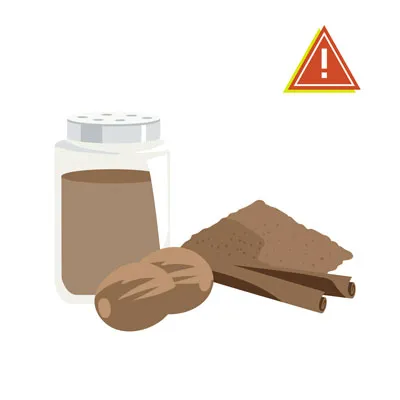 Nutmeg seeds and cinnamon sticks, spices that are harmful or irritating for dogs.
Nutmeg seeds and cinnamon sticks, spices that are harmful or irritating for dogs.
13. Onions, Garlic, Chives, and Leeks
Many pet owners are surprised to learn that herbs and vegetables from the allium family, including onions, garlic, chives, and leeks, are highly toxic to dogs. These plants contain sulfoxides and disulfides, compounds that can damage a dog’s red blood cells, leading to a serious condition called hemolytic anemia. Symptoms of anemia can include weakness, lethargy, pale gums, and difficulty breathing.
It’s crucial to be aware that onion and garlic powders are common ingredients in many prepared human foods, including some baby foods and broths. Always read food labels carefully before offering any store-bought items to your pet. All allium plants can cause potentially fatal anemia in both dogs and cats. Certain Japanese breeds, such as Akitas and Shiba Inus, are particularly sensitive, but these plants are dangerous for all dogs, regardless of breed.
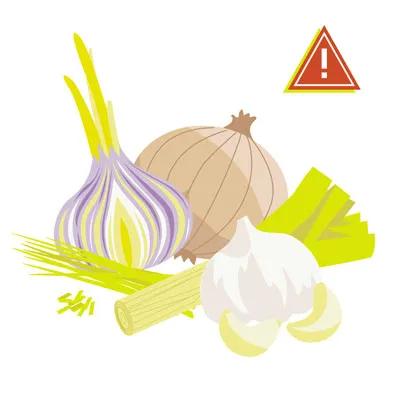 Onions, garlic cloves, and fresh chives, representing toxic allium vegetables for dogs.
Onions, garlic cloves, and fresh chives, representing toxic allium vegetables for dogs.
14. Salt
While a small amount of salt is essential for bodily functions, excessive amounts can be extremely dangerous for dogs. Too much salt can disrupt the delicate fluid balance of cells throughout your dog’s body, leading to a condition known as sodium ion poisoning. This can manifest as tremors, seizures, severe diarrhea, vomiting, and in severe cases, even coma or death. Whether your dog is eyeing salty snacks like potato chips, or potentially ingesting rock salt used for de-icing, or even homemade play dough (which often contains high levels of salt), always ensure they avoid high-sodium items to protect their health.
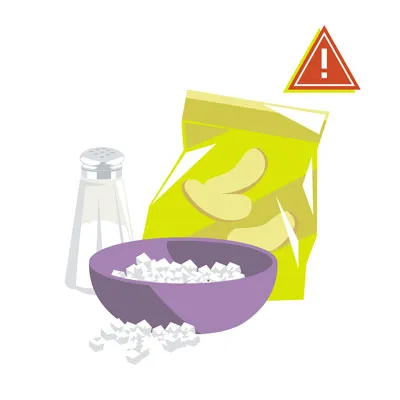 Pile of salt crystals, indicating that excessive salt intake is dangerous for dogs.
Pile of salt crystals, indicating that excessive salt intake is dangerous for dogs.
15. Spicy Food
Spicy foods are generally a bad idea for dogs. Ingredients like chili peppers or other strong spices can cause significant gastrointestinal irritation. This can lead to painful vomiting, stomach ulcers, or severe diarrhea. Beyond the immediate discomfort and pain for your dog, such incidents can result in expensive emergency veterinary visits. It’s best to keep your canine companion’s diet bland and free from any spicy human foods.
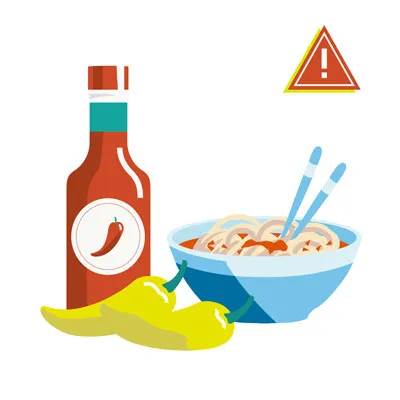 Hot chili peppers and a spice grinder, representing spicy foods that can cause digestive upset in dogs.
Hot chili peppers and a spice grinder, representing spicy foods that can cause digestive upset in dogs.
16. Sugar-Free Gum and Candy (Xylitol)
Xylitol is a sugar substitute widely used in many human foods, including sugar-free gum, candies, baked goods, certain peanut butters, and even some toothpastes. In dogs, xylitol is incredibly toxic and can cause a rapid and profound drop in blood sugar (hypoglycemia), leading to weakness, disorientation, and seizures. In more severe cases, it can result in liver failure, which is often fatal.
The incidence of dog poisoning cases involving this artificial sweetener is alarmingly on the rise. To illustrate the severe danger, the amount of xylitol found in just five pieces of sugar-free gum has the potential to be lethal to a 65-pound dog. Always check ingredient labels carefully, especially for “sugar-free” or “diet” products, and keep all such items securely out of your dog’s reach.
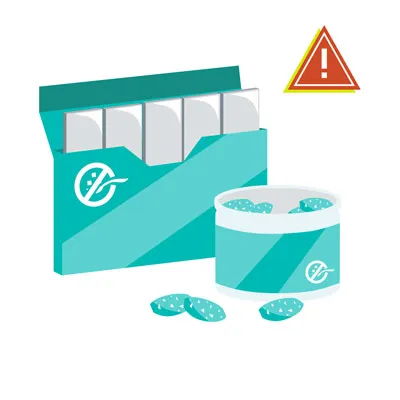 Sugar-free gum and candy wrappers, signifying products containing xylitol that are toxic to dogs.
Sugar-free gum and candy wrappers, signifying products containing xylitol that are toxic to dogs.
17. Tomatoes and Raw Potatoes
Both tomatoes and potatoes fall into a category of foods that are safe in some forms but highly unsafe in others. A ripened red tomato, when given in moderation, is generally considered safe for dogs. However, the green parts of the tomato plant—including stems, leaves, and green, unripe tomatoes—contain solanine, a glycoalkaloid that is toxic to dogs and can cause gastrointestinal upset, lethargy, and weakness.
Similarly, cooked potatoes (baked or boiled, without additives) are generally safe in small amounts. However, raw potatoes, especially those with green spots or sprouts, also contain solanine and should not be fed to dogs. Always ensure potatoes are fully cooked and peeled before offering a small, plain portion to your pet.
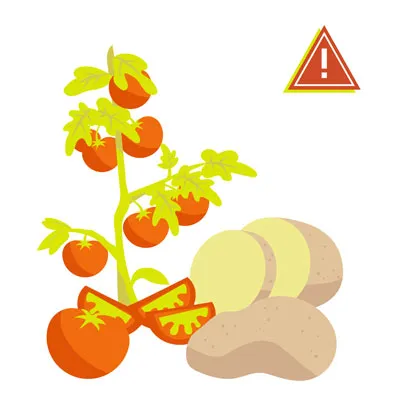 Green unripe tomatoes and raw potatoes, illustrating parts of these plants that are toxic to dogs.
Green unripe tomatoes and raw potatoes, illustrating parts of these plants that are toxic to dogs.
18. Tobacco
Tobacco products, in any form, are extremely dangerous and unhealthy for your dog. They contain nicotine, a potent neurotoxin that can be rapidly absorbed. Even small exposures to nicotine-containing products (cigarettes, cigars, chewing tobacco, e-cigarettes, nicotine patches) can cause a variety of severe symptoms, including vomiting, diarrhea, rapid or labored breathing, agitation, abnormal heart rate, wobbliness, muscle weakness, fluctuations in blood pressure, seizures, and tremors.
More significant or frequent exposure can lead to blue-tinged gums, coma, and ultimately, be fatal. Dogs are naturally curious and might nose through an ashtray, pick up a discarded cigarette butt on a walk, or even chew on an e-cigarette device. If your dog ingests any amount of tobacco or a nicotine product, it is a medical emergency; you must act fast and take them to the veterinarian immediately.
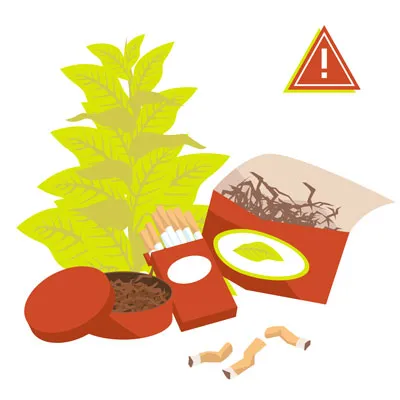 Cigarettes and tobacco leaves, representing nicotine products that are highly toxic to dogs.
Cigarettes and tobacco leaves, representing nicotine products that are highly toxic to dogs.
19. Yeast and Raw Dough
Yeast and raw dough are particularly hazardous for dogs for several critical reasons. Firstly, raw dough can expand significantly in your dog’s warm stomach, leading to severe pain, bloating, and potentially life-threatening gastric dilatation-volvulus (GDV), or “bloat,” which can involve stomach torsion or rupture.
Secondly, the yeast and sugar in raw dough undergo fermentation in the digestive tract, producing alcohol. This can rapidly lead to alcohol toxicity, with symptoms ranging from disorientation and vomiting to seizures, respiratory failure, and death. This condition is a dire medical emergency requiring immediate veterinary intervention. Always keep raw dough and yeast-containing products well out of your dog’s reach.
 Raw bread dough in a bowl, showing the potential danger of yeast and unbaked dough for dogs.
Raw bread dough in a bowl, showing the potential danger of yeast and unbaked dough for dogs.
20. Raw Meat
Never feed your dog raw or undercooked meat. While some proponents advocate for raw food diets, the risks associated with raw meat, even for dogs, are significant. Raw or undercooked meat can harbor harmful bacteria such as Salmonella, E. coli, and Listeria, which can cause severe gastrointestinal illness in dogs and also pose a risk of cross-contamination to humans in the household. Furthermore, raw meat often contains bones, and these can pose a serious choking hazard or cause internal damage, splintering and perforating the digestive tract. Always ensure any meat given to your dog is thoroughly cooked and boneless.
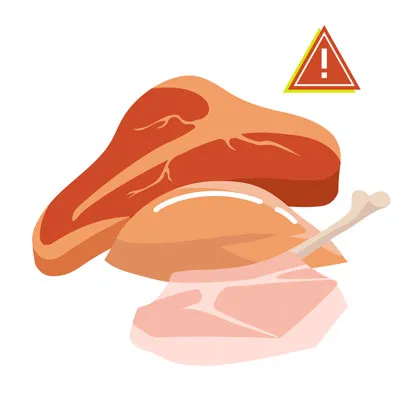 Raw beef steak on a cutting board, emphasizing that raw meat should not be given to dogs due to bacteria and bone risks.
Raw beef steak on a cutting board, emphasizing that raw meat should not be given to dogs due to bacteria and bone risks.
21. Rhubarb
Rhubarb, a common ingredient in many human desserts like pies, is not safe for pets. Its leaves, and to a lesser extent its stalks, contain soluble calcium oxalate crystals. If ingested in sufficient quantities, these crystals can bind with calcium in the dog’s body, causing a dangerous drop in blood calcium levels (hypocalcemia) and potentially leading to acute renal failure. Symptoms of rhubarb poisoning can include tremors, weakness, excessive drooling, bloody urine, changes in thirst and urination patterns, and vomiting.
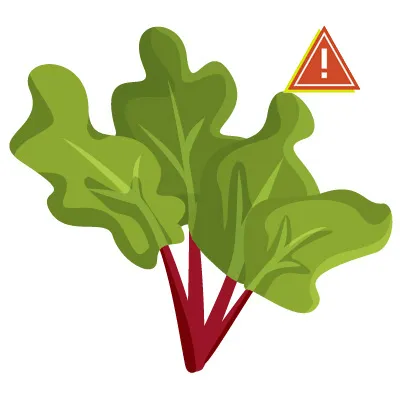 Fresh rhubarb stalks and leaves, highlighting a plant that is toxic to dogs.
Fresh rhubarb stalks and leaves, highlighting a plant that is toxic to dogs.
22. Star Fruit
Much like rhubarb, star fruit also contains soluble calcium oxalate crystals. For this reason, it is advisable to prevent your dog from consuming star fruit. Ingestion can lead to similar issues as rhubarb, including kidney damage and disruptions in calcium balance, particularly if consumed in large amounts or by dogs with pre-existing kidney conditions.
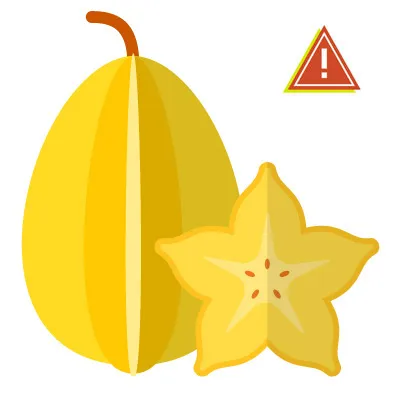 Sliced star fruit showing its distinctive shape, a fruit that is not safe for dogs.
Sliced star fruit showing its distinctive shape, a fruit that is not safe for dogs.
23. Flavored Water and Seltzer Water
When it comes to your dog’s hydration, always err on the side of caution and provide only fresh, clean tap water rather than any flavored or carbonated beverages. Flavored waters and seltzer waters can contain various added ingredients that may be dangerous for pups, including artificial sweeteners (like xylitol), high sugar content, artificial flavors, or excessive salt. Plain seltzer water, while possibly non-toxic in very small amounts if urgently needed, can cause gas and uncomfortable bloating due to its carbonation. The safest and healthiest choice for your dog’s hydration remains plain, unadulterated water.
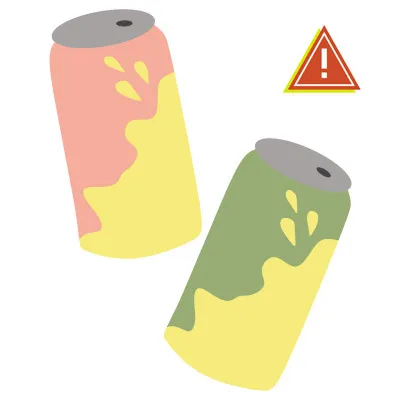 Glass of seltzer water with lime, advising against flavored or carbonated drinks for dogs.
Glass of seltzer water with lime, advising against flavored or carbonated drinks for dogs.
What to Do If Your Dog Eats Something Toxic
Despite our best efforts, accidents can happen. If you suspect your dog has ingested a toxic food, immediate action is crucial. Being prepared and knowing how to respond can significantly improve your dog’s outcome.
First, familiarize yourself with the common symptoms of food toxicity. These can vary depending on the specific substance ingested but often include listlessness, signs of distress or pain (such as whining or hunched posture), vomiting, diarrhea (which may be bloody), loss of appetite, excessive drooling, tremors, seizures, changes in behavior, or difficulty breathing. In some cases, a dog’s abdomen might become bloated from gas and feel hard to the touch—a painful and potentially life-threatening condition that can lead to stomach rupture if not treated promptly.
If you observe any of these symptoms or strongly suspect toxic ingestion, take the following steps without delay:
- Call your veterinarian or a pet poison control center immediately. Time is of the essence in cases of poisoning. Treatments are generally far more successful, and the duration of hospitalization is significantly reduced, when a dog receives prompt professional help. Do not wait for symptoms to worsen.
- Be ready with all important information. When you call, be prepared to provide details such as the type of food eaten, the approximate amount consumed, and the exact time of ingestion. If you have the packaging of the ingested item, have it ready as it may contain crucial ingredient information.
- Avoid home remedies unless specifically instructed by your veterinarian. Never try to induce vomiting, administer medications, or attempt other home treatments without professional guidance. What might be helpful for one type of toxin could be harmful for another (e.g., inducing vomiting can be dangerous if the dog ingested a corrosive substance or is already showing neurological symptoms). Your vet will advise the safest course of action based on the specific situation.
Having contact information for emergency veterinarians (available 24/7) and poison control readily accessible can make a critical difference in these urgent situations.
Preventing Accidental Ingestion: Keeping Your Dog Safe
Proactive measures are the most effective way to safeguard your beloved pup from the dangers of unsafe human foods. While accidents are sometimes unavoidable, implementing these preventative strategies can significantly minimize the risks.
1. Store Foods Out of Reach
The simplest and most effective prevention method is to ensure that all potentially toxic foods are stored where your dog cannot access them. This means keeping dangerous items on high shelves, securely inside pantries with childproof locks, or in cabinets that your ingenious pup can’t open. Never leave toxic foods unattended on countertops, low tables, or anywhere within jumping or reaching distance.
2. Avoid Feeding Dogs from Your Plate
It’s a habit many of us develop, but feeding your dog directly from your plate or offering scraps while you’re cooking can be problematic. This teaches them to beg for human food and makes it harder for them to differentiate between safe and unsafe items. It’s safest to only give your pup treats that are specifically formulated and approved for dogs. If you want to share a healthy human food, always prepare it separately and offer it in their bowl.
3. Educate Family Members and Guests
Ensure everyone in your household, including children and visitors, is aware of the specific foods that are dangerous for dogs. Clearly communicate that, no matter how much your dog begs or how tempting it might be, they should never sneak any food to your canine companion without your explicit approval. Consistency from all family members is key to reinforcing safe habits.
4. Be Careful During Holidays and Gatherings
Holidays and social gatherings are often high-risk times for pet poisonings. The increased hustle and bustle, coupled with an abundance of unfamiliar and rich human foods, can make it easy to let your guard down. Be extra cautious during these periods. Designate a “safe zone” for your dog away from food preparation and serving areas, and remind guests about your pet’s dietary restrictions. Being prepared for emergencies, such as having your vet’s contact info or poison control numbers handy, is especially important during busy times.
Healthy Alternatives: Safe Human Foods for Dogs
While the list of foods dogs can’t eat is long, the good news is that there’s also an extensive list of human foods that are perfectly safe and can even be healthy additions to your dog’s diet, in moderation. These can make excellent treats or meal toppers, provided they are prepared correctly and offered in appropriate quantities. Here are some popular and safe options that your dog might enjoy. For a more detailed guide on what is good human food to feed dogs, explore our dedicated articles.
1. Apples, Oranges, and Bananas
- Apples: The fleshy parts of apples, thoroughly cored and seeded, are perfectly fine. Cut them into small pieces to prevent choking and ensure no seeds are present, as apple seeds contain cyanide.
- Oranges: Safe in small amounts. Be sure to remove the peel and seeds, as these can be difficult to digest or contain oils that might cause stomach upset.
- Bananas: In moderation and without the peel, bananas can be a tasty and potassium-rich treat.
2. Blueberries and Blackberries
These small berries are fantastic, antioxidant-rich treats that many dogs absolutely love. Blueberries, in particular, are packed with antioxidants, fiber, phytochemicals, and vitamin C, making them a great health booster for your pup. Blackberries offer similar nutritional benefits.
3. Cantaloupe, Mango, Peaches, Pears, Pineapples, and Watermelons
Many fruits offer safe and delicious options for your dog. Experiment to see which ones they enjoy most!
- Cantaloupe: A great choice, rich in vitamins A and C.
- Watermelon: A refreshing treat, especially on warm days, as it’s mostly water. Always remove the rinds and all seeds (including the pale, underdeveloped seeds in “seedless” varieties) to prevent choking and digestive upset.
- Mangoes, Peaches, Pears, and Pineapples: All safe in moderation. Critically, ensure all seeds, pits, and cores are removed before offering these to your dog, as they can be toxic or choking hazards.
4. Carrots, Cucumber, and Celery
Looking for more healthy and low-calorie ideas? Remember these three “C’s”:
- Carrots: Crunchy, bite-sized carrot pieces are a favorite for many dogs. They are low in calories and good for dental health.
- Cucumbers: Sliced cucumbers are packed with vitamins and minerals, with very few carbohydrates or fats, making them an excellent choice for overweight dogs.
- Celery: Offers a satisfying crunch and can even help freshen bad breath.
These vegetables are particularly great options for dogs watching their weight. Check out what vegetables can you feed your dog for more veggie ideas.
5. Cheese
While dairy can be problematic for some dogs, small amounts of certain cheeses can be an acceptable treat if your dog is not lactose intolerant. Opt for lower-fat varieties like mozzarella or cottage cheese as an occasional treat, and always consult your veterinarian if you have concerns about the best type and quantity. High-fat cheeses should be avoided due to the risk of pancreatitis.
6. Eggs
Fully cooked eggs, such as scrambled or hard-boiled, can be a delicious and highly beneficial treat for your dog. They are an excellent source of protein and can even help soothe an upset stomach. Ensure eggs are cooked thoroughly to eliminate the risk of salmonella.
7. Peanuts, Peanut Butter, and Cashews
- Peanuts and Cashews: Safe for dogs in small quantities, provided they are unsalted, unseasoned, and unflavored. Due to their high fat content, offer them sparingly as an occasional treat.
- Peanut Butter: A popular, high-protein treat in moderation. Always choose unsalted peanut butter and, most importantly, confirm it does not contain xylitol, which is highly toxic to dogs.
8. Popcorn and Corn
- Popcorn: Air-popped, unsalted, and unbuttered popcorn can be a fun treat. Thoroughly inspect it to ensure there are no unpopped kernels, which can be a choking hazard or get lodged in their teeth.
- Corn: Removed from the cob, plain corn kernels are acceptable. Avoid butter, salt, or spices.
9. Coconut and Honey
- Coconut: In small amounts, coconut (including coconut milk and coconut oil) is generally fine for dogs. It contains lauric acid, which may offer health benefits. However, some dogs might experience an upset stomach from fresh coconut or coconut milk, so introduce it cautiously. Avoid coconut water (which can be high in potassium) and never allow your dog to eat the fibrous shell, which is a choking hazard.
- Honey: In moderation, honey is safe and provides various vitamins, minerals, and antioxidants beneficial for your pup.
10. Shrimp and Fish
- Shrimp: Plain, fully cooked shrimp makes a great protein-rich treat. Always remove the shell, head, tail, and legs, and ensure it’s not seasoned, salted, or buttered.
- Fish: Many types of fish, particularly salmon and sardines, are permissible. Ensure the fish is plain, thoroughly cooked, and completely boneless. A good general guideline is to offer fish no more than twice a week. Plain, canned tuna (packed in water, not oil) is also safe in moderation to limit mercury and salt intake.
11. Turkey
Plain, cooked turkey meat is a healthy and safe source of protein for dogs. Always remove the skin, excess fat, and all bones before offering small, unseasoned bites as a delicious treat. Avoid anything seasoned, spiced, or salted.
12. Grains, Wheat, and Quinoa
Grains, wheat, and quinoa can be part of a dog’s diet in moderation, assuming no allergies. A little bit of wheat or other grains, similar to corn, is generally fine. Quinoa is a healthier option compared to many other common fillers found in pet foods. As with any new food, monitor your dog for any signs of allergic reactions.
13. Green Beans
Green beans are a popular and excellent choice for dogs. Whether served raw, steamed, or from a can (plain, no salt added), they are safe, tasty, and healthy. Look for green beans that are raw or cooked without added spices, oils, or salt. Cut them into small, bite-sized pieces to prevent choking, especially for smaller dogs.
Factors Increasing Risk: Which Dogs Are Most Vulnerable?
While all dogs should avoid toxic foods, certain groups are at higher risk if they consume something harmful. Understanding these vulnerabilities can help you be even more diligent in protecting your specific pet.
- Small Breeds vs. Large Breeds: Smaller dogs are generally more vulnerable to toxins due to their lower body weight. A dose of a toxic substance that might cause mild symptoms in a large dog could be severely dangerous or even fatal for a tiny breed. This is particularly true for substances like chocolate, where the toxic dose is calculated per pound of body weight.
- Puppies: Young dogs have less developed digestive systems and immune responses, making them more susceptible to the adverse effects of certain substances. Their curiosity also means they are more likely to explore and ingest things they shouldn’t. This includes not just toxic foods but also general food safety, as their developing systems may not handle even some raw dog food as safely as an adult. For specific guidance on what to give a labrador puppy to eat, specialized resources are available.
- Elderly Dogs: Older dogs may have compromised immune systems, slower metabolism, or underlying health conditions that make them more susceptible to toxic effects. Their bodies may not process or eliminate toxins as efficiently as younger, healthier dogs.
- Dogs with Pre-existing Conditions: Dogs suffering from chronic illnesses such as diabetes, kidney disease, liver disease, or gastrointestinal sensitivities are at a significantly higher risk. Their existing health issues can be exacerbated by toxic foods, and their bodies may struggle to cope with the additional stress of poisoning.
Being aware of these factors for your individual dog can help you tailor your prevention strategies and heighten your vigilance, ensuring an even safer environment for your beloved companion.
Conclusion
Navigating the world of human foods and their potential impact on your dog’s health can seem daunting, but it is an essential part of responsible pet ownership. As experts at Dog Care Story, our primary goal is to empower you with the knowledge to make informed decisions that ensure your canine companion’s safety and well-being. By understanding [What Are Some Foods That Dogs Can T Eat] and the specific dangers they pose, you are taking a crucial step towards preventing avoidable emergencies.
Remember, a dog’s digestive system is unique and highly sensitive to certain compounds that are perfectly harmless to humans. Vigilance in food storage, consistency in feeding habits, and educating your entire household are paramount to creating a safe environment. While this guide provides a comprehensive list of harmful foods and offers safe alternatives, it’s vital to always consult your veterinarian if you have any doubts about a particular food or if your dog has ingested something questionable. Their professional expertise is your best resource in protecting your pet.
We encourage you to explore other articles on Dog Care Story for more valuable insights into canine health, nutrition, and care. By staying informed and proactive, you can ensure a long, healthy, and happy life for your cherished dog. Your dedication to their safety is the greatest gift you can offer.
References
- “Top 10 dog poisons,” Hilary Parker (5/2023), WebMD, https://www.webmd.com/pets/dogs/top-10-dog-poisons
- “What happens if a dog eats chocolate?” (10/2023), Colorado State University, https://vetmedbiosci.colostate.edu/vth/animal-health/why-is-chocolate-bad-for-dogs/
- “Fruits and vegetables dogs can or can’t eat,” (3/2024), American Kennel Club, https://www.akc.org/expert-advice/nutrition/fruits-vegetables-dogs-can-and-cant-eat/
- “What to do if your dog drinks alcohol,” Jerry Klein (7/2023), American Kennel Club, https://www.akc.org/expert-advice/vets-corner/is-alcohol-dangerous-for-dogs/
- “Can dogs eat apples?” Hector Joy (12/2022), PetMD, https://www.petmd.com/dog/general-health/can-dogs-eat-apples
- “Can dogs eat plums?” Katie Koschalk (7/2023), Chewy, https://be.chewy.com/nutrition-pet-diet-tips-can-dogs-eat-plums/
- “Avocado (Persea spp) Toxicosis in Animals,” Cristine Hayes (9/2024), Merck Veterinary Manual, https://www.merckvetmanual.com/toxicology/food-hazards/avocado-persea-spp-toxicosis-in-animals
- “People foods to avoid feeding your pets,” (n.d.), ASPCA, https://www.aspca.org/pet-care/animal-poison-control/people-foods-avoid-feeding-your-pets
- “People foods dogs can and can’t eat,” (3/2024), American Kennel Club, https://www.akc.org/expert-advice/nutrition/human-foods-dogs-can-and-cant-eat/
- “Can dogs eat nuts?” Amanda Ardente (1/2023), PetMD, https://www.petmd.com/dog/nutrition/can-dogs-eat-nuts
- “Can dogs drink milk?” Sandra C. Mitchell (1/2024), PetMD, https://www.petmd.com/dog/nutrition/can-dogs-drink-milk
- “Can dogs have nutmeg?” Barri J. Morrison (11/2023), PetMD, https://www.petmd.com/nutmeg-safe-dogs
- “Onion, garlic, chive, and leek poisoning in dogs,” Renee Schmid et al. (2024), VCA Animal Hospitals, https://vcahospitals.com/know-your-pet/onion-garlic-chive-and-leek-toxicity-in-dogs
- “Can dogs eat tomatoes?” Anna Burke (10/2024), American Kennel Club, https://www.akc.org/expert-advice/nutrition/can-dogs-eat-tomatoes/
- “Can dogs eat potatoes?” Katherine Ripley (11/2023), American Kennel Club, https://www.akc.org/expert-advice/nutrition/can-dogs-eat-potatoes/
- “What to do if your dog eats a cigarette butt,” (6/2023), American Kennel Club, https://www.akc.org/expert-advice/health/dog-ate-cigarette-butt/
- “Dough & dogs: Why it’s bad and what you can do,” Lisa Goldstein (7/2024), Preventive Vet, https://www.preventivevet.com/dogs/dough-is-toxic-to-dogs
- “Rhubarb,” (n.d.), Pet Poison Helpline, https://www.petpoisonhelpline.com/poison/rhubarb/
- “Can dogs drink carbonated water?” Heather Logue (n.d.), Rover, https://www.rover.com/blog/can-dogs-drink-carbonated-water/
- “What fruits can dogs eat?” Ellen Malmanger (2/2024), PetMD, https://www.petmd.com/dog/nutrition/what-fruits-can-dogs-eat
- “Can dogs have green beans?” Anna Burke (8/2022), American Kennel Club, https://www.akc.org/expert-advice/nutrition/can-dogs-have-green-beans/
- “About pet food safety,” (4/2024), CDC, https://www.cdc.gov/healthy-pets/about/pet-food-safety.html
